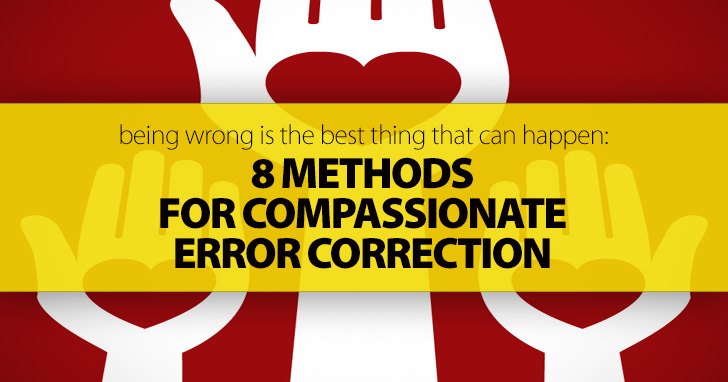Being Wrong Is The Best Thing That Can Happen: 8 Methods for Compassionate Error Correction


We’re always aiming not to disrupt fluency too much, nor to single out individuals or make students feel bad for having tried something ambitious. But we’re also keenly aware of the importance of accuracy, and of not letting too many mistakes go past without being corrected.
One good way to achieve this balance is to return the students mistakes to them in the form of a worksheet. This way, the problem is written down, which gives it clarity, and is available to everyone, so that the whole class benefits from the correction process. It is also a fun opportunity and frequently raises some good laughs.

Your source material for creating these worksheets will be the students themselves. All language teachers are listening out for problems, and many of them you’ll want to correct, right there on the spot. Others, though, you can let go but note down in your planning book. As the week progresses, you’ll build up a brief page of errors. You might include the name of the student, but this isn’t for punitive purposes! Knowing who made the error lets you listen for an improvement from that individual.
Other sources include homework, particularly writing and free production, and tests. The purposes is never to embarrass anyone, so please don’t pick out examples where the student has entirely failed to understand the question, or given a ‘guesswork’ answer. Chose those errors which illustrate a larger problem, such as:
Many examples, for example that last one about the crowd, are potentially very funny. I always note down mistakes which make me laugh; the humor adds to the experience, cementing this learning moment in the students’ mind. One of my all-time favorites, captured just before break time during the audio taping of a model lesson, was this gem from a Colombian lady:
| Teacher: | Are you going to have a snack at break time? |
| Student: | Yes. Banana. |
| Teacher: | Oh, let’s go for a full sentence. You know how I love those. |
| Student. | (Thinking) OK. Every day, I am banana. |
The subsequent error correction sheet included this phrase, and neither I, nor any of the students, have ever forgotten it.

I give each sheet a date and the same type of title. E.g. “Upper Intermediate Error Correction, 15th December.”
I then either simply create a numbered list of the erroneous sentences, with no guidance as to what the problem might be, or create short dialogues to give the sentence some context. For instance, the above example about the banana would make no sense without the question from the teacher, neither would a measure word problem be comprehendible without knowing what’s being measured. A typical list of questions (this one is from an Intermediate class of largely Spanish speakers, as you may be able to deduce) looks like this:
Leave space under each question so that the students can write their corrections in.
I tend to decorate the page with a couple of relevant pictures of pieces of clip-art, and use different colors (in schools with a color copier machine).
The students work in pairs or trios, and have 8-12 minutes to work through the sheet, depending on its length and the level of the class. Their objectives are three-fold:
I stick to the time limit, and ensure that everyone is kept on track. This is intended to be a short, intensive exercise. If students finish early, I always have an extra game in my ‘back pocket’.
Once the time is up, it’s time for feedback. You can simply rotate around the class, have one student name the next person to answer, or ask students at random. They should follow the three steps above: identify the problem, describe why this is wrong, and then suggest a fix.
Most of the time, there will be several ways to fix the problem, so invite other students to contribute their answers, too. You could confirm the best answer by writing it on the board, or do so verbally, depending on the level of your class.
This is an important skill; practicing it makes it more likely your students will self-correct, and it is a gentle and often humorous way of dealing with errors, something which many students find embarrassing or deflating. I recommend a weekly, or at most twice-weekly exercise, lasting only ten minutes (plus feedback) to bring new accuracy to your students’ work.